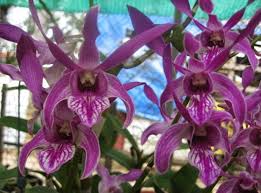# The Best Times to Propagate Dendrobium Orchids

Dendrobium orchids, known for their stunning flowers and wide range of species, are among the most popular orchids cultivated by enthusiasts and growers. Propagating these beautiful plants can be a rewarding experience, but timing is crucial to ensure success. This comprehensive guide will explore the best times to propagate Dendrobium orchids, discussing seasonal factors, growth cycles, and techniques to help you achieve the best results.
## 1. Understanding Dendrobium Orchids
### 1.1 Overview of Dendrobium Orchids
Dendrobium orchids belong to the Orchidaceae family and are one of the largest genera of orchids, comprising over 1,800 species. These orchids are native to Asia, particularly in regions with tropical and subtropical climates, such as Thailand, Indonesia, and the Philippines. They are known for their diverse flower shapes, colors, and sizes, making them highly sought after by collectors and growers.
### 1.2 Growth Habits and Life Cycle
Dendrobium orchids typically grow in a sympodial manner, meaning they produce new growths from the base of older pseudobulbs. These pseudobulbs store water and nutrients, allowing the plant to thrive during dry periods. Dendrobiums generally have two growth phases: the active growth phase and the dormant phase.
– **Active Growth Phase**: This phase occurs during the warm, wet seasons when the orchid produces new shoots, leaves, and roots. During this time, the plant requires more water, light, and nutrients.
– **Dormant Phase**: Following the active growth phase, Dendrobium orchids enter a dormant period, usually triggered by cooler temperatures and reduced light. During dormancy, the plant conserves energy and nutrients, requiring less water and care.
Understanding these growth habits is essential for determining the optimal time to propagate Dendrobium orchids.
## 2. Timing for Propagation
### 2.1 Best Seasons for Propagation
The best time to propagate Dendrobium orchids typically aligns with their natural growth cycle. Here’s a breakdown of the seasons and their suitability for propagation:
– **Spring (March to May)**: Spring is often regarded as the best time to propagate Dendrobium orchids. During this season, the temperatures rise, and daylight hours increase, signaling the start of the active growth phase. New shoots begin to emerge, and the plant is primed for propagation. Propagating during spring allows the new divisions to establish roots and grow vigorously as the weather warms up.
– **Summer (June to August)**: Early summer can also be a suitable time for propagation, particularly for certain Dendrobium species that continue to grow actively during this period. However, it’s essential to monitor environmental conditions, such as humidity and temperature, to ensure successful rooting.
– **Fall (September to November)**: While late summer to early fall can still provide opportunities for propagation, it’s generally less ideal. By this time, many Dendrobium orchids are preparing for dormancy. If propagation is attempted during this season, it may be more challenging for the new divisions to establish themselves before the onset of colder weather.
– **Winter (December to February)**: Winter is generally the least favorable time for propagation. Dendrobium orchids are in their dormant phase during this time, and the cold temperatures can hinder the growth of new roots and shoots. Therefore, it’s best to avoid propagation during winter months.
### 2.2 Observing Growth Patterns
In addition to seasonal factors, it’s essential to observe the growth patterns of your Dendrobium orchids. Specific indicators can help determine the right time for propagation:
– **New Growth Emergence**: Look for the emergence of new shoots or growths. This typically indicates that the orchid is ready for propagation. New shoots usually form after the last blooms fade.
– **Health of the Plant**: Ensure the parent plant is healthy and free from diseases or pests. A vigorous and robust plant will yield better propagation results.
– **Root Development**: Check the root system of the parent plant. Healthy, well-established roots will support successful propagation. If the plant appears root-bound, it may be a good time to divide and propagate.
## 3. Propagation Techniques
### 3.1 Division
Division is one of the most common methods for propagating Dendrobium orchids. This technique involves separating the plant into smaller sections, each with roots and pseudobulbs. Here’s how to perform this method effectively:
#### Steps for Division
1. **Prepare the Tools**: Ensure you have clean, sharp tools, such as a knife or garden shears, to prevent infection and promote clean cuts.
2. **Remove the Orchid from the Pot**: Gently take the Dendrobium orchid out of its pot, being careful not to damage the roots.
3. **Examine the Roots and Pseudobulbs**: Look for healthy sections of the plant that have multiple pseudobulbs and strong root systems. Each division should ideally have at least two to three pseudobulbs.
4. **Make Clean Cuts**: Use your knife or shears to separate the chosen divisions from the main plant. Ensure that each division has roots attached.
5. **Pot the Divisions**: Place each division into a new pot with fresh orchid potting mix. Ensure that the roots are spread out, and the pseudobulbs are above the soil line.
6. **Watering and Care**: Water the newly potted divisions lightly to encourage root growth, and provide indirect light and high humidity.
### 3.2 Stem Cuttings
While less common, stem cuttings can be an effective propagation method for certain Dendrobium species. This technique involves taking a healthy stem and encouraging it to root.
#### Steps for Stem Cuttings
1. **Select a Healthy Stem**: Choose a mature stem with several nodes. It should be free from any signs of disease or damage.
2. **Cut the Stem**: Using clean tools, cut a section of the stem about 6-8 inches long, ensuring it has at least one node.
3. **Prepare for Planting**: Allow the cut end to dry and callous over for a few hours to reduce the risk of rot.
4. **Potting**: Place the cutting in a pot with a suitable orchid growing medium. Ensure the node is buried, as this is where roots will develop.
5. **Watering and Care**: Keep the cutting in a warm, humid environment and provide indirect light. Mist regularly to maintain humidity.
### 3.3 Keiki Development
Keikis, or “baby orchids,” are small plants that grow from the nodes of the parent Dendrobium orchid. They can be left to grow until they develop their root system or can be separated for propagation.
#### Steps for Keiki Propagation
1. **Wait for Keiki Formation**: Monitor your Dendrobium for the formation of keikis, which typically occurs during the active growth phase.
2. **Allow Root Development**: If the keiki has developed roots of at least 2-3 inches, it can be separated from the parent plant.
3. **Cut the Keiki**: Use clean tools to cut the keiki from the parent plant, ensuring that you include the root system.
4. **Pot the Keiki**: Place the keiki in its pot with fresh potting medium and water lightly.
5. **Care for the Keiki**: Provide proper light, humidity, and water to encourage healthy growth.
## 4. Post-Propagation Care
After propagating Dendrobium orchids, proper care is essential to ensure the success of the new plants.
### 4.1 Watering
Water the newly propagated plants lightly, allowing the growing medium to dry out slightly between waterings. Overwatering can lead to root rot, while underwatering can hinder growth.
### 4.2 Light Requirements
Provide bright, indirect light to the newly propagated orchids. Direct sunlight can scorch the leaves, while too little light can inhibit growth. Consider using sheer curtains to filter light if necessary.
### 4.3 Fertilization
Fertilize the newly propagated Dendrobiums with a balanced orchid fertilizer. Dilute the fertilizer to half strength and apply every 4-6 weeks during the active growth phase. Avoid fertilizing during the dormant phase.
### 4.4 Monitoring Health
Regularly check the health of the propagated plants for signs of pests or diseases. Healthy plants will show new growth and vibrant leaves. Address any issues promptly to prevent them from spreading.
## 5. Challenges in Propagation
### 5.1 Environmental Factors
Propagation success can be influenced by environmental factors such as temperature, humidity, and light. Fluctuations in these factors can stress the plants and hinder root development.
### 5.2 Pest and Disease Management
Newly propagated plants may be susceptible to pests such as aphids, mealybugs, and spider mites. Fungal diseases can also pose a threat. Maintaining a clean growing environment and monitoring for issues is crucial.
### 5.3 Patience and Timing
Propagation can take time, and not all attempts will be successful. Understanding the timing and growth cycles of Dendrobium orchids is essential for achieving the best results.
## 6. Conclusion
Dendrobium orchids are a delightful addition to any garden or collection, and knowing the best times to propagate these plants can enhance your gardening experience. Spring remains the ideal season for propagation, aligning with the active growth phase of the plants. By utilizing methods such as division, stem cuttings, and keiki propagation, you can successfully create new Dendrobium orchids to enjoy.
With proper care and attention to environmental factors, your newly propagated Dendrobium orchids will flourish, providing beauty and elegance for years to come. Whether you are an experienced
grower or a novice enthusiast, understanding the best practices for propagation will set you on the path to success in cultivating these magnificent orchids.

